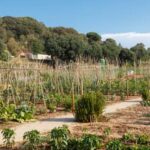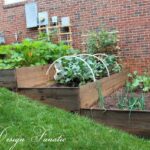Have you ever dreamed of having a thriving vegetable garden in your backyard? Whether you are a beginner or an experienced gardener, this beginner’s guide to vegetable gardening will help you get started on the right foot. From selecting the right location to maximizing space in your backyard, this article covers everything you need to know to grow your own vegetables.
When it comes to gardens, vegetable backyard spaces offer endless possibilities for growing a wide variety of fresh and delicious produce. In this comprehensive guide, we will take you through the essential steps of starting and maintaining a successful vegetable garden in your own backyard. We will cover everything from choosing the right location and preparing the soil, to selecting the best vegetables for your garden and dealing with pests and diseases.
With the increasing interest in sustainable living and organic produce, more and more people are turning to vegetable gardening as a way to have access to fresh, healthy food right at their doorstep. Whether you have acres of land or just a small plot in your backyard, anyone can enjoy the satisfaction of growing their own vegetables. So let’s dive into the world of vegetable gardening and learn how you can start your very own backyard garden today.
Choosing the Right Location for Your Vegetable Garden
When it comes to starting a vegetable garden in your backyard, one of the most crucial decisions you’ll make is choosing the right location for it. The success of your garden depends greatly on its location, so it’s important to consider several factors when making this decision.
First and foremost, look for a spot in your backyard that receives at least 6-8 hours of sunlight each day. Most vegetables need plenty of sunlight to grow and thrive, so selecting a sunny location is key. Additionally, make sure the area has good drainage to prevent waterlogging, as overly wet soil can lead to root rot and other issues.
Another consideration when choosing the right location for your vegetable garden is proximity to a water source. Since regular watering is essential for healthy plant growth, it’s best to pick a spot that’s easily accessible to a water hose or irrigation system. This will make it much more convenient for you to keep up with the watering needs of your plants.
Finally, take into account any potential obstacles such as trees or structures that could cast shade on your garden or compete with vegetables for water and nutrients. Keep in mind that tall plants such as corn or pole beans should be positioned on the north side of the garden so they don’t shade smaller plants.
| Aspect | Consideration |
|---|---|
| Sunlight | 6-8 hours per day for most vegetables |
| Drainage | Good drainage to prevent waterlogging |
| Water Source | Proximity to a water source for easy access |
Preparing the Soil for a Successful Vegetable Garden
Testing and Amending the Soil
Before you start planting your vegetable garden, it’s crucial to test and amend the soil to ensure that it has the necessary nutrients for your plants to thrive. You can purchase a soil testing kit at your local gardening store or send a sample to a professional laboratory for analysis.
Once you know the pH levels and nutrient composition of your soil, you can add organic matter such as compost, manure, or mulch to improve its fertility. By amending the soil, you are creating an optimal environment for your vegetables to grow healthy and strong.
Tilling and Aerating the Soil
Proper tilling and aerating of the soil are essential steps in preparing it for a successful vegetable garden. Tilling helps break up compacted soil and create a loose texture that allows plant roots to penetrate easily. Aerating the soil improves its drainage and facilitates air circulation, which is vital for root development.
You can use a rototiller or garden fork to till the soil, making sure to incorporate any amendments thoroughly. Keep in mind that over-tilling can disrupt the natural structure of the soil, so strive for balance in this process.
Mulching for Weed Control and Moisture Retention
Applying mulch to your vegetable garden serves multiple purposes, including weed control and moisture retention. By laying down a layer of organic mulch such as straw, wood chips, or shredded leaves, you can suppress weed growth and reduce the need for frequent watering.
Mulch also acts as an insulating layer that helps maintain consistent soil temperature throughout the growing season. Remember to replenish the mulch as needed to keep it at an adequate thickness, providing ongoing benefits for your backyard vegetable garden.
Selecting the Best Vegetables for Your Backyard Garden
When it comes to selecting the best vegetables for your backyard garden, there are a few factors to consider. First, think about what vegetables you and your family enjoy eating the most. This will ensure that you actually use the produce from your garden and not let it go to waste.
Additionally, consider the climate and growing conditions in your area. Some vegetables thrive in warmer weather, while others prefer cooler temperatures. Researching which vegetables are best suited for your specific location will help set you up for success.
Another important factor to consider when selecting vegetables for your backyard garden is the amount of space you have available. If you have a smaller garden, opt for vegetables that can be grown in containers or vertically, such as tomatoes, peppers, or pole beans. For larger gardens, you have the flexibility to plant a wider variety of vegetables including squash, cucumbers, and corn.
Additionally, consider the yield of each vegetable. If you have limited space but still want a bountiful harvest, prioritize vegetables that produce a high yield per plant.
Finally, think about the level of maintenance each vegetable requires. Some plants are low-maintenance and perfect for beginner gardeners, while others may require more attention and care. Consider how much time and effort you are willing to put into maintaining your vegetable garden and choose plants accordingly.
Planting and Maintaining Your Vegetable Garden
Once you have chosen the vegetables you want to grow in your backyard garden, it’s time to start planting and maintaining them. Proper care and maintenance are crucial for the success of your vegetable garden. Here are some tips to help you get started:
1. Planting your vegetables: When planting your vegetables, make sure to follow the spacing guidelines provided on the seed packets or plant labels. Proper spacing will ensure that your plants have enough room to grow without competing for resources. Consider using raised beds or containers to maximize space and improve drainage.
2. Maintaining your vegetable garden: Regular maintenance is essential for a healthy vegetable garden. This includes watering, fertilizing, weeding, and mulching. Water your plants regularly, keeping the soil consistently moist but not waterlogged. Use organic fertilizers to provide essential nutrients for healthy growth. Weeding is also important to prevent competition for water and nutrients.
3. Protecting your plants: Consider using natural pest control methods such as companion planting, attracting beneficial insects, or using physical barriers like row covers to protect your plants from pests and diseases. Inspect your garden regularly for any signs of infestation or disease and take appropriate measures to address them.
Following these tips will help you maintain a thriving vegetable garden in your backyard.
Remember that gardening is not just about planting seeds and watching them grow; it’s a continuous process that requires attention and care throughout the growing season. With dedication and effort, you can enjoy a bountiful harvest of fresh, homegrown vegetables from your own backyard garden.
Watering and Irrigation Tips for a Thriving Garden
When it comes to maintaining a thriving vegetable garden, proper watering and irrigation are key factors in ensuring the health and productivity of your plants. Here are some essential tips to help you keep your garden well-watered and flourishing:
- Watering Schedule: Establishing a consistent watering schedule is crucial for the success of your backyard vegetable garden. Different vegetables have varying water needs, so it’s important to research the specific requirements of each type of plant. Generally, most vegetables need about 1-2 inches of water per week, either through rainfall or manual irrigation.
- Irrigation Methods: There are several methods you can use to effectively water your vegetable garden, including hand watering with a hose or watering can, drip irrigation, soaker hoses, and sprinkler systems. Each method has its own advantages and disadvantages, so consider factors such as water efficiency, ease of use, and cost when choosing the best option for your garden.
- Timing: The timing of watering is also an important consideration. It’s best to water your vegetable garden early in the morning or late in the afternoon to minimize evaporation and allow the plants to absorb the water before the heat of the day sets in.
Proper watering is essential for the overall health and productivity of your vegetable garden. By following these tips and staying attentive to the moisture needs of your plants, you can ensure that your backyard garden stays healthy and productive throughout the growing season.
Remember that overwatering or underwatering can both have negative effects on plant growth, so be mindful of striking a balance and adjusting your watering routine as needed based on weather conditions and plant development.
In addition to proper watering techniques, consider incorporating mulch around your plants to help retain moisture in the soil and reduce weed growth. With attentive care and thoughtful irrigation practices, you can enjoy a bountiful harvest from your backyard vegetable garden all season long.
Dealing With Pests and Diseases in Your Vegetable Garden
One of the biggest challenges that vegetable gardeners face is dealing with pests and diseases that can harm their plants. It’s important to be vigilant and proactive in order to protect your garden and ensure a bountiful harvest. There are several organic methods that can be used to prevent and control pests and diseases without resorting to harmful chemicals.
First, it’s important to keep your garden clean and tidy. Remove any dead or diseased plant material, as this can attract pests and allow diseases to spread. Regularly inspect your plants for any signs of infestation or illness, such as holes in leaves, discolored spots, or wilted stems. Early detection is key when it comes to preventing the spread of pests and diseases.
In addition to maintaining a clean garden, you can also introduce beneficial insects that prey on common garden pests. Ladybugs, lacewings, and praying mantises are all natural predators that can help keep pest populations in check. This biological control method is not only effective, but it’s also environmentally friendly. Choosing resistant varieties of vegetables can also help reduce the risk of disease taking hold in your garden.
| Common Garden Pests | Organic Pest Control Methods |
|---|---|
| Aphids | Introduce ladybugs or spray with insecticidal soap |
| Caterpillars | Pick off by hand or use Bacillus thuringiensis (BT) |
| Slugs and snails | Set out beer traps or use diatomaceous earth |
By implementing these organic pest control methods and staying attentive to the health of your plants, you can protect your vegetable garden from the most common pests and diseases. This will ultimately lead to a more successful harvest of homegrown produce from your backyard garden.
Harvesting and Enjoying the Fruits of Your Labor
After months of hard work, it’s finally time to reap the rewards of your labor in the backyard vegetable garden. Harvesting and enjoying the fresh produce from your own garden is one of the most satisfying experiences for any gardener. Here are some tips to make the most of your vegetable harvest.
Harvesting at the Right Time
One of the keys to enjoying the best flavor and quality from your homegrown vegetables is harvesting them at the right time. Each vegetable has its own ideal harvesting time, whether it’s when they reach a certain size, color, or level of ripeness. For example, tomatoes should be picked when they are fully colored and slightly soft to the touch, while leafy greens like lettuce and spinach can be harvested when they reach a size suitable for eating.
Proper Storage and Preservation
Once you’ve harvested your vegetables, proper storage is essential to maintain their freshness and flavor. Some vegetables can be stored in a cool, dry place like a root cellar or pantry, while others may require refrigeration or freezing. Additionally, consider preservation methods such as canning or pickling to enjoy your homegrown vegetables all year round.
Sharing Your Bounty
If you find yourself with more vegetables than you can consume, consider sharing your bounty with friends, family, or neighbors. Not only does this foster a sense of community, but it also prevents wastage and allows others to enjoy the fruits of your labor.
When it comes to harvesting and enjoying the fruits of your labor in your backyard vegetable garden, remember that patience and care during each step of the process will lead to delicious results. Whether you’re savoring a freshly picked salad or preserving an abundance of produce for future enjoyment, growing your own vegetables is truly a rewarding experience.
Maximizing Space in Your Backyard Vegetable Garden
When it comes to growing your own vegetables in a backyard garden, maximizing space is essential for a successful and bountiful harvest. With the right planning and techniques, even a small backyard can yield an abundance of fresh produce. Here are some tips for maximizing space in your backyard vegetable garden.
One way to maximize space in your backyard vegetable garden is to utilize vertical gardening techniques. This involves growing plants upward using trellises, stakes, or cages, rather than allowing them to sprawl out across the ground. Vertical gardening not only saves space, but it also makes it easier to care for and harvest your crops. Vining vegetables such as tomatoes, cucumbers, and pole beans are ideal candidates for vertical gardening.
Another effective method for maximizing space in a backyard vegetable garden is interplanting. This technique involves planting different types of vegetables together in the same area, allowing them to take advantage of available space while also benefiting from companion planting relationships. For example, you can plant fast-growing crops like lettuce or radishes between rows of slower-growing plants such as tomatoes or peppers.
Finally, consider incorporating raised beds into your backyard vegetable garden design. Raised beds not only help optimize limited space by providing more planting area within a defined space but also offer better soil drainage and easier access for maintenance and harvesting. Additionally, you can create multiple levels of raised beds to further maximize space and create visual interest in your garden.
By implementing these strategies for maximizing space in your backyard vegetable garden, you can make the most of whatever area you have available and enjoy an abundant harvest of fresh, homegrown produce.
Conclusion
Growing your own vegetables in your backyard garden can be a truly rewarding experience. Not only does it provide you with fresh, organic produce, but it also allows you to connect with nature and develop a greater appreciation for the food that sustains us.
As mentioned in this beginner’s guide to vegetable gardening, there are several important factors to consider when starting your own garden, from choosing the right location and preparing the soil to selecting the best vegetables for your climate and planting schedule.
One of the most satisfying aspects of vegetable gardening is being able to harvest and enjoy the fruits of your labor. There’s nothing quite like picking a ripe, juicy tomato or plucking a crisp, vibrant bell pepper from your own garden and incorporating it into your meals. The taste and satisfaction of knowing that you have nurtured these plants from seeds to fully grown vegetables is unparalleled.
Maximizing space in your backyard vegetable garden can also be a fun challenge. Whether you have a small urban backyard or a larger suburban one, there are creative ways to make the most of the available space and grow an abundance of delicious produce.
Utilizing vertical gardening techniques, companion planting, and succession planting are just a few ways to ensure that every square foot of your garden is productive. With patience, dedication, and attentiveness, anyone can experience the joy of growing their own vegetables right in their backyard.

If you’re looking to get into vegetable gardening, or are just looking for some tips on how to make your current garden better, then you’ve come to the right place! My name is Ethel and I have been gardening for years. In this blog, I’m going to share with you some of my best tips on how to create a successful vegetable garden.





